Batman (TV series) facts for kids
Quick facts for kids Batman |
|
|---|---|
 |
|
| Genre |
|
| Created by | William Dozier |
| Developed by | Lorenzo Semple Jr. |
| Starring | |
| Narrated by | William Dozier |
| Opening theme | "Batman Theme" by Neal Hefti |
| Composer(s) |
|
| Country of origin | United States |
| Original language(s) | English |
| No. of seasons | 3 |
| No. of episodes | 120 (list of episodes) |
| Production | |
| Executive producer(s) | William Dozier |
| Producer(s) | Howie Horwitz |
| Editor(s) | Byron Chudnow |
| Camera setup | Single-camera |
| Running time | 25 minutes |
| Production company(s) |
|
| Release | |
| Original network | ABC |
| Original release | January 12, 1966 – March 14, 1968 |
Batman was a super fun American TV show from the 1960s. It was based on the famous DC Comics character, Batman. The show starred Adam West as Batman and Burt Ward as Robin. These two crime-fighting heroes worked together to protect Gotham City from many tricky villains.
The series was known for its silly, over-the-top style and its catchy theme song. It was made to be funny and teach simple lessons about right and wrong to younger viewers. A total of 120 episodes aired on the ABC network. It ran for three seasons from January 12, 1966, to March 14, 1968. For the first two seasons, new episodes came out twice a week. In the third season, it was once a week.
In 2016, TV experts called Batman the 82nd greatest American TV series ever. There was also a movie released in 1966, right between the first and second seasons of the show. For a long time, Batman held the record for the most episodes of a live-action superhero TV series. Later, another show called Smallville broke that record in 2007.
Contents
What was the show about?
The Batman TV series followed Batman and Robin as they fought crime in Gotham City. We sometimes saw their normal lives as millionaire Bruce Wayne and his young helper Dick Grayson. But usually, they were quickly called away to fight bad guys.
The "Dynamic Duo" often helped the Gotham City Police Department when supervillains caused trouble. These villains usually had helpers and, sometimes, a stylish female companion. In each episode, Batman and Robin would follow strange clues, using their special "bat logic," to figure out the villain's plan. Then, they would stop the plan and catch the criminal.
For the first two seasons, Batman aired twice a week on back-to-back nights. Most stories were split into two parts. There were a couple of three-part stories in the second season, where villains teamed up. The titles of these multi-part stories often rhymed.
The third and final season had one episode a week. This season also introduced Yvonne Craig as Barbara Gordon/Batgirl. Each story in the third season was complete in one episode. At the end of each episode, they would show a sneak peek of the villain for the next week. The exciting cliffhangers from earlier seasons, where Batman or Robin were in danger, were usually solved quickly at the start of the next episode.
The show was meant to be a crime series, but it was very silly and funny on purpose. It made situations seem much bigger and funnier than they were. But the characters always acted very serious, even when things were totally absurd!
Who were the main characters?
Regular heroes and helpers
- Adam West as Bruce Wayne / Batman: He's a very rich businessman whose parents were sadly murdered when he was a child. He secretly uses his money and skills to fight crime as the superhero Batman. Adam West was chosen for the role because he could say funny lines with a serious face.
- Burt Ward as Dick Grayson / Robin: Batman's young helper, also known as the "Boy Wonder." He's a high school student. The show didn't really explain how he became Batman's sidekick.
- Alan Napier as Alfred: Batman's loyal butler. He's also Batgirl's secret helper. Alfred is the only one who knows that Bruce Wayne, Dick Grayson, and Barbara Gordon are secretly superheroes.
- Neil Hamilton as Commissioner Gordon: The head of the Gotham City Police Department. He's one of Batman's main police contacts. He calls Batman and Robin using the special Batphone or the Bat Signal.
- Stafford Repp as Chief O'Hara: Gotham City's Chief of Police and Batman's other main police contact. This character was created just for the show.
- Madge Blake as Harriet Cooper: Dick Grayson's aunt. She appeared in the comics before the show to give Bruce and Dick a reason to keep their secret identities hidden.
- Yvonne Craig as Barbara Gordon / Batgirl: Commissioner Gordon's daughter and a librarian in Gotham City. She joined Batman and Robin as a crime-fighter in the third season. Sometimes, they were called the "Terrific Trio."
- William Dozier as Narrator (uncredited): The show's executive producer also narrated the episodes, adding to the fun.
Adam West once said that he knew the show would be funny when he read a script where Batman, in his full costume, asked for a quiet booth in a nightclub because he "shouldn't wish to attract attention." The idea of Batman trying to be unnoticed in a bright costume was hilarious!
Famous villains
The show featured many classic villains from the Batman comics. Here are some of the most famous ones:
- Cesar Romero as The Joker: A clown-themed villain who loves pranks and leaves jokes as clues. He's Batman's biggest enemy.
- Burgess Meredith as The Penguin: A fancy thief who looks like a penguin and uses special umbrellas for his crimes.
- Frank Gorshin (Seasons 1 and 3) and John Astin (Season 2) as The Riddler: A criminal who leaves tricky riddles as clues for Batman to solve.
- Julie Newmar (Seasons 1–2), Eartha Kitt (Season 3), and Lee Meriwether (1966 Batman movie) as The Catwoman: A cat-themed jewel thief. She has a complicated love-hate relationship with Batman.
- Victor Buono as Professor William McElroy / King Tut: An expert on ancient Egypt who changes into a pharaoh-like villain when he gets hit on the head.
- George Sanders (Season 1), Otto Preminger and Eli Wallach (Season 2) as Dr. Art Schivel / Mr. Freeze: A mad scientist who needs to stay in freezing temperatures to live. He uses a gun that can freeze things solid.
- Vincent Price as Egghead: A very smart, bald villain whose crimes and way of speaking are all about eggs.
How were the episodes made?
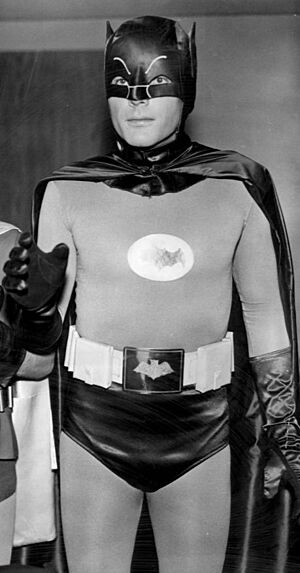
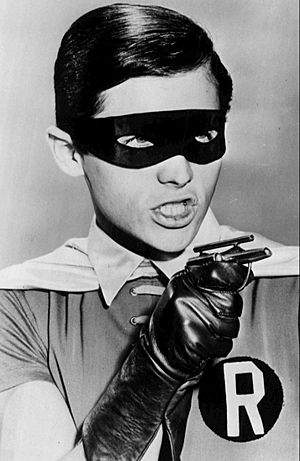
Season 1 fun facts
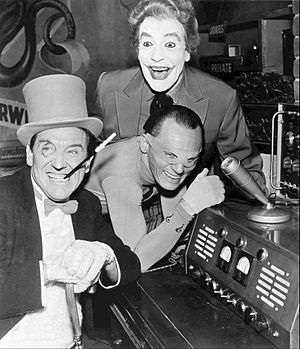
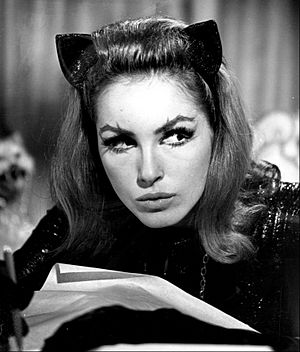
The show's head writer, Lorenzo Semple Jr., wrote the first episode. He liked a pop-art adventure style. Other writers, like Stanley Ralph Ross, often added more silly comedy. The show was first planned to be an hour long. But because ABC needed half-hour slots, it was split into two 30-minute parts. These aired on Wednesdays and Thursdays, with a cliffhanger connecting them, just like old movie serials.
The villains were very important to the plots. For example, Frank Gorshin was chosen to play the Riddler because he had been a big Batman fan since he was a kid. Catwoman was played by three different actresses: Julie Newmar in the first two seasons, Lee Meriwether in the movie, and Eartha Kitt in the third season. The show was incredibly popular and was a huge hit in the mid-1960s.
Season 3 changes

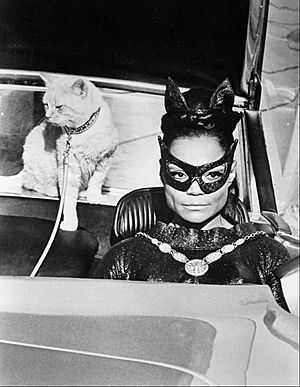
By the third season, fewer people were watching the show. To get new viewers, the creators decided to add a female superhero: Batgirl. She was Commissioner Gordon's daughter, Barbara. A special short film was made to convince ABC to add Batgirl, played by Yvonne Craig. Batgirl was the first female superhero to be a regular character on TV!
The show was cut down to once a week, and most episodes told a complete story. At the end of each episode, they would show a preview of the next week's villain. Aunt Harriet appeared less often in the third season because of Madge Blake's health and to make room for all the characters in a shorter episode. Eartha Kitt took over the role of Catwoman because Julie Newmar was busy with a movie.
The show's style became even more unusual and artistic in the third season. It also started to include more references to the popular trends and slang of the 1960s, like "hippies" and "mods." The sets also changed, using more simple, stylized cutouts against a black background.
Episode style and format
The show's silly style was shown in many ways, like the villains' costumes and the funny dialogue. Batman often used his many cool gadgets, which had funny names like "Shark Repellant Bat-Spray." The narrator, William Dozier, would end cliffhanger episodes by saying, "Tune in tomorrow – same Bat-time, same Bat-channel!" During the big fight scenes, words like "POW!" and "BAM!" would pop up on the screen, just like in comic books.
A typical episode would start with a villain doing something bad. Commissioner Gordon and Chief O'Hara would figure out who it was, realize they needed help, and call Batman on the Batphone. At "stately Wayne Manor," Alfred would answer and make a funny excuse to get Bruce Wayne and Dick Grayson away from Aunt Harriet. Batman and Robin would race to police headquarters in the Batmobile and start working on the case. They would find the villain, get into a fight, and then get caught in a silly trap. This was the cliffhanger! The next episode would show them escaping the trap in a super funny way. This pattern of investigating, fighting, and catching the villain would repeat until the final big fight.
The show also had "Window Cameos." As Batman and Robin climbed up a building, a famous person would pop out of a window and make a joke.
Why the show ended
Near the end of the third season, fewer people were watching, and ABC decided to cancel the show. Another network, NBC, wanted to take over. But before they could, it was discovered that many of the expensive Batman sets had been destroyed. Since it would cost too much to rebuild them, NBC decided not to pick up the show.
Cool camera tricks
From the very beginning, the cameras were often tilted, making the scenes look a bit crooked. This was called a "Dutch tilt." Characters were filmed from high and low angles. This trick was often used in the villains' hideouts to make the scenes look like a comic book and to show that the bad guys were "crooked."
The Batmobile
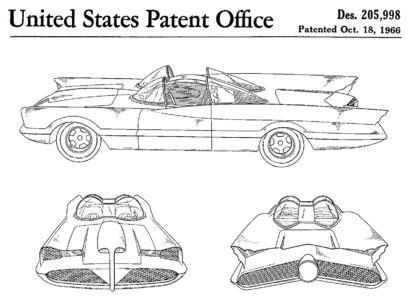
The amazing Batmobile from the 1960s TV series was sold at an auction in January 2013 for $4.2 million! It was built by George Barris from a special concept car.
Reunions and other appearances
Many of the actors from the show reunited over the years or played their characters again.
- In 1977, Adam West and Burt Ward voiced Batman and Robin in an animated series called The New Adventures of Batman.
- In 1979, West, Ward, and Frank Gorshin (the Riddler) appeared in two TV specials called Legends of the Superheroes.
- In 2003, West and Ward starred in a TV movie called Return to the Batcave: The Misadventures of Adam and Burt. It mixed new scenes with younger actors playing the original cast, and West and Ward searching for a stolen Batmobile.
- Burt Ward also made a cameo as an older Dick Grayson in the 2019 "Crisis on Infinite Earths" TV crossover event. He even shouted, "Holy crimson skies of death!"
Spin-off movies and comics
Batman (1966 film)
A movie based on the TV show, also called Batman, came out in 1966. It was meant to introduce the show, but the TV series started first. The movie was made quickly between the first and second seasons. It helped pay for cool new vehicles like the Batboat and Batcopter, which were then used in the TV show.
Batman: Return of the Caped Crusaders
An animated movie, Batman: Return of the Caped Crusaders, was released in 2016 to celebrate the show's 50th anniversary. Adam West and Burt Ward voiced Batman and Robin again, and Julie Newmar returned as Catwoman.
Batman vs. Two-Face
A sequel to the animated movie, Batman vs. Two-Face, came out in 2017. It featured William Shatner as the voice of Two-Face. This was one of Adam West's last acting roles before he passed away.
Batman '66 comics
In 2013, DC Comics started a new comic book series called Batman '66. These comics told brand new stories set in the world of the 1960s TV show. They featured classic villains like Joker, Penguin, Riddler, and Catwoman, and even introduced some new ones to the TV show's world.
Collectibles and toys
Since 1966, tons of Batman merchandise has been made because the TV show was so popular. This includes trading cards, model kits of the Batmobile, coloring books, and board games. These old items are now very popular with collectors.
Toy companies like Mattel have made many versions of the 1966 Batmobile for their Hot Wheels line. In 2013, Mattel also released action figures based on the TV series, featuring the actors' likenesses.
In 2016, to celebrate the show's 50th anniversary, Lego released a special set: the 76052 Classic TV series Batcave. It included minifigures of Batman, Robin, Bruce Wayne, Dick Grayson, and the main villains.
Legacy of the show
The stars of the series, Adam West and Burt Ward, were often remembered mostly for their roles as Batman and Robin for many years. Later, an episode of Batman: The Animated Series paid tribute to Adam West. He voiced an old superhero actor who inspired Bruce Wayne as a child. This helped West become popular with a new generation of fans. He also voiced Mayor Grange in The Batman and Bruce Wayne's father in Batman: The Brave and the Bold. West eventually loved his connection to the series.
See also
 In Spanish: Batman (serie de televisión) para niños
In Spanish: Batman (serie de televisión) para niños

